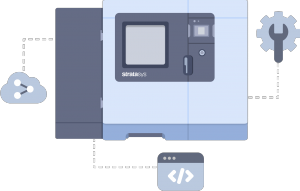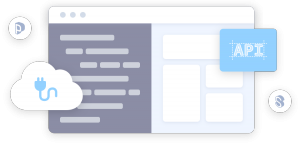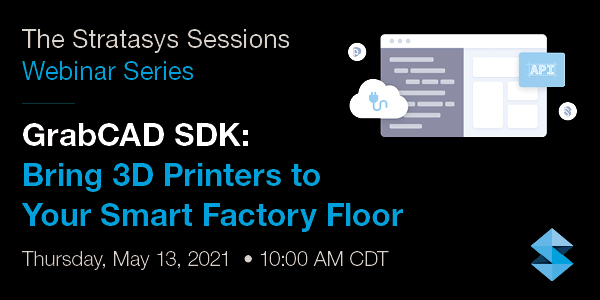As 3D printers become increasingly part of the manufacturing floor, whether as part of an additive manufacturing (AM) fleet of 3D printers, or mixed in with traditional "subtractive manufacturing" machines, 3D printers offer exciting new opportunities for existing and new manufacturing plants.
The benefits 3D printing offers include:
- Changes in the economics of production.
- Design freedom.
- Augmented part functionality.
- Product personalization.
- Environmental sustainability.
- New supply and business models, such as distributed manufacturing.
But many 3D printing factories aren’t getting the most out of their 3D printers. For example:
- Printing jobs may not be getting scheduled optimally.
- Consumables may not be getting resupplied in time.
- Failures in multi-hour or multi-day print jobs may not be getting detected as early as possible, resulting in lost productivity time and wasted materials.
- Potential printer problems may not be detected in time to fix them before a machine fails.
The reason: many 3D printers are not yet connected to (or integrated with) the company's other manufacturing equipment, or to the factory floor and business software programs that control and monitor them.
This software infrastructure can include ERP (Enterprise Resource Planning), BI (Business Intelligence), PLM (Product Lifecycle Management), MES (Manufacturing Execution Systems), and BI (Business Intelligence) software.
One key component that helps the integration of 3D printers and their related software to the rest of the factory's software infrastructure is machine connectivity -- enabled by APIs; and to build those integration efficiently, is through the provision of Software Development Kits (SDKs).
In December 2020, Stratasys introduced new GrabCAD Software Development Kits.

According to Stratasys, "Each SDK package includes a complete set of Application Programming Interfaces, documentation, and code samples that enable development partners and manufacturing customers to establish two-way connectivity between Stratasys FDM® 3D printers and enterprise software applications. The program gives customers the power to integrate, manage, and support additive manufacturing for production of end-use parts."
Here's some of the benefits that companies ramping up their Additive Manufacturing will get as their software vendors make use of the software development kits that go with their new 3D printers.
Manage Multiple 3D Printers
A large 3D printing business may have multiple printers ; however, if the company can't control them through a central program, it will be hard to assign and schedule print jobs optimally. Not to mention it’ll be hard to monitor the machines and their output to spot potential problems more quickly.
Connect Printers with Existing and New Manufacturing and Business Systems
Most factories already have their own software for job scheduling, machine control, and other aspects of the parts-to-product manufacturing chain.
"Traditional manufacturers -- for example, with CNC (Computer Numerical Control) equipment for sheet metal bending -- already have MES software they may have been using for a long time," says Frank Lindeman, Software Customer Success Engineer EMEA at Stratasys.
"These factories want to continue using their existing software. So when they get new equipment like a Stratasys 3D printer and GrabCAD software they want it to work with their existing factory and business software -- and SDKs make it easier for the software companies to make that integration happen."
Reduce The Total Amount of Software Needed to Be Used on a Factory Floor
If all a factory's machines, whether they're Additive, machining, or sheet metal, support the same standardized API, that makes it much easier for the company to use one piece of software to collect data from these machines.
"Reducing the number of software tools can reduce the cost of PCs on the shop floor, operator training for these tools, and reduces errors that might happen if operators have to switch among multiple control programs that each have their own look-and-feel and way of working," says Lindeman.
For example, Stratasys includes the API for MTConnect, an industry standard for machine sensor and status data, on their top end FDM manufacturing machines.
Greater Flow of Printer Data Metrics And Other Factory Floor Data
The GrabCAD SDKs enable integration of additive manufacturing into the production workflow with machine monitoring and data collection and job programming. This makes it possible for you to retrieve job data, including:

- Print job file (CMB/.PRINT)
- Job build parameters (printer type, material, build resolution, infill patterns, etc.)
- Job estimates of build time and material usage
Equally, the integration enabled by SDKs can let companies incorporate 3D printers into their existing methods.
"Many companies want to use their existing Manufacturing Execution Software (MES) rather than the GrabCAD Print software to do the sending and scheduling of 3D printing jobs like to which printer and at what time, to which printer, at what time," notes Lindeman.
"3D printers and other manufacturing equipment don't just take in data telling them what to do," points out Lindeman. "These machines also generate data, on everything from consumables status to metrics on items as they are made, along with diagnostic and error codes about the machine. With this data, a manufacturer can track and assess production metrics, equipment effectiveness, and energy use.
By having better software integration among your manufacturing floor and your business system, you can prevent print failures. Lindeman explains:
"For example, a failed build that ran for 72 hours on one of our printers is expensive -- if the software integration made possible by a SDK means you get data to tell you to stop after only ten or fifteen minutes, that's well worth the investment."
Improved Workflow and Flexibility by Allowing Software Partners and Larger/Custom Manufacturers to Create Custom Solutions

By facilitating the connections and data flow between 3D printers and other factory and business software, SDKs let integrators and larger/custom manufacturers put together 3D printing ecosystems tailored to specific requirements. These can range from seasonal and constantly-changing specifications to single parts printed at remote locations like airports or offshore oil platforms for quick repairs.
Without Software Development Kits, this kind of integration would be harder-to-impossible. SDKs let all manufacturers looking to add or ramp up their Additive Manufacturing capabilities "smartly," taking advantage of Industry 4.0 methods for productivity and flexibility.
Learn more about the GrabCAD Software Development Kit and GrabCAD Software Partner Program in this on-demand webinar:





